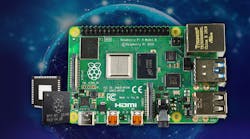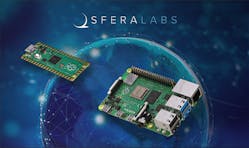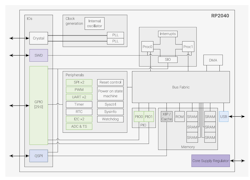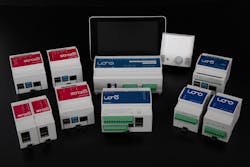This article is part of the TechXchange: Raspberry Pi.
What you’ll learn:
- An overview of the RP2040 system.
- Choosing between a Raspberry Pi and an RP2040.
- Industrial applications that leverage Pi.
As the first microcontroller product from the Raspberry Pi Foundation, the RP2040 marked a new direction for an organization best known for its single-board computers (SBCs). Bringing the Pi’s signature values of high performance, low cost, and ease of use to the microcontroller space, the RP2040 represents a significant next step in the evolution of a technology that has delivered low-cost, easy-access computing to millions of users around the world since 2012. Here we will consider how the micro differs from a Raspberry Pi SBC (Fig. 1).
A microcontroller is a small computer on a single integrated circuit (IC) that includes a microprocessor, memory, and input/output (I/O) peripherals. It's designed to control specific tasks and perform specific functions in a compact form factor. The microcontroller's main role is to control other devices and interact with the environment by collecting sensor data, processing it, and triggering outputs.
Microcontrollers are limited in processing power, memory, and storage capacity compared to a computer, but this is makes them ideal for small, low-power, cost-effective embedded systems. Unlike computers, microcontrollers are optimized to run a single application and don’t require an operating system or a graphical user interface (GUI).
RP2040 and Raspberry Pi 4
Manufactured on a 40-nm process node, the RP2040 combines high performance with low dynamic power consumption and incorporates a variety of low-power modes to support extended duration operation while on battery power (Fig. 2). With a large on-chip memory, dual-core processor, and a comprehensive peripheral set—augmented with a unique programmable I/O (PIO) subsystem—it provides professional users with significant power and flexibility.
The device features a dual Arm Cortex-M0+ core operating at 133 MHz plus 264 kB of on-chip SRAM, and it offers support for up to 16 MB of off-chip flash memory. Peripherals include UARTs, SPI controllers, I2C controllers, 16 PWM channels, and a USB 1.1 controller and PHY with host and device support, while four of the 30 GPIO pins can be used as analog inputs.
The RP2040's small form factor, low power consumption, and high performance make it suitable for a wide range of IoT and embedded-systems applications, including open solutions for automation and control. The Raspberry Pi RP2040 enables programming in C/C++ and MicroPython, and it ensures compatibility with several IDEs, including Visual Studio Code and the Arduino IDE.
Software development is simplified thanks to the convenience of drag-and-drop programming using mass storage over USB and on-chip boot loaders. All coding resources, tools, examples, and the vast community support available for the RP2040—as well as the open-source libraries and applications developed by companies such as Sfera Labs and available on GitHub—can be accessed to easily develop professional solutions.
Unlike the RP2040, the Raspberry Pi 4 is a single-board computer that runs a full operating system, such as Raspberry Pi OS or other Linux-based distributions. The board offers significant increases in processor speed, multimedia performance, memory, and connectivity compared to previous Pi SBCs, though it retains backwards compatibility and operates with similar levels of power consumption.
The product’s key features include a high-performance, 64-bit, quad-core Arm Cortex-A72 processor running at up to 1.5 GHz, up to 8 GB of RAM, and a range of I/O peripherals such as GPIO, USB, Ethernet, and HDMI. Dual-display support for resolutions up to 4K and built-in hardware video decode, alongside integrated dual-band wireless LAN and Bluetooth, mean that the Raspberry Pi 4 is a versatile computer offering performance comparable to entry-level x86 PC systems. It can be used for a wide range of applications, including programming, web development, media centers, and gaming.
Once again, thanks to a vast ecosystem of tools and support, sensor and control applications can be built quickly and cost-effectively. Meanwhile, modular compliance certification for wireless and LAN communications allows the board to be designed into end products with significantly reduced compliance testing, improving both cost and time-to-market.
Micro or SBC?
Choosing between a Raspberry Pi and an RP2040 will, ultimately, depend on the specific requirements of an individual project and a wide variety of factors ranging from performance to power consumption, form factor to functionality, and protocols support to available interfaces.
Certainly, the RP2040 is a good choice for designers seeking real-time performance and minimum energy use—a key issue for battery-powered IoT applications. Its low-level architecture and lack of an operating system provide for predictable and deterministic response times while keeping power consumption to a minimum. However, where there’s a need for a full operating system and a highly flexible, scalable, and future-proofed solution, it’s likely that the Raspberry Pi is a better choice.
Remember that the term "real-time" is often used in embedded computing to describe systems that respond immediately to inputs and events. However, real-time is a relative term. A real-time system simply does what you expect it to do when you expect it to do it. For example, in some applications, a delay of a few milliseconds or even seconds may not significantly impact the overall system performance.
Finally, the RP2040 and Raspberry Pi can also be combined in distributed systems to take advantage of their unique capabilities. For instance, an application could run time- or safety-critical tasks on the RP2040, and high-level or resource-demanding tasks on the Raspberry Pi.
Pi in Industrial Applications
The Raspberry Pi Foundation’s primary goal is to advance the education of adults and children, particularly in the field of computers, computer science, and related subjects. However, as we have mentioned, the power, flexibility, and affordability of the organization’s platforms, coupled with the fact that Raspberry Pi offers open-source development, also makes it increasingly attractive for commercial applications in the automation and control space.
As a result, there are a growing number of Raspberry Pi-based alternatives, including those from Sfera Labs to traditional closed, proprietary solutions (Fig. 3).
Because they’re part of an extended ecosystem of tools, reference designs, and community support and are readily understood by a large number of developers, these platforms can help to reduce development time and cost without sacrificing functionality or performance.
Read more articles in the TechXchange: Raspberry Pi.



